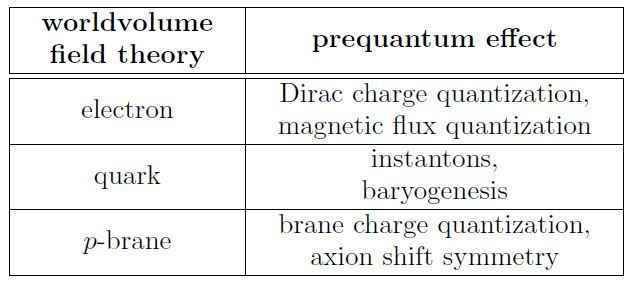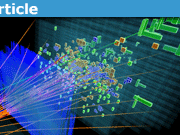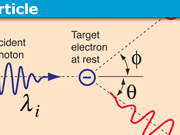Higher Prequantum Geometry I: The Need for Prequantum Geometry
Show Complete Series
Part 1: Higher Prequantum Geometry I: The Need for Prequantum Geometry
Part 2: Higher Prequantum Geometry II: The Principle of Extremal Action – Comonadically
Part 3: Higher Prequantum Geometry III: The Global Action Functional — Cohomologically
Part 4: Higher Prequantum Geometry IV: The Covariant Phase Space – Transgressively
Part 5: Higher Prequantum Geometry V: The Local Observables – Lie Theoretically
Part 6: Examples of Prequantum Field Theories I: Gauge Fields
Part 7: Examples of Prequantum Field Theories II: Higher Gauge Fields
Part 8: Examples of Prequantum Field Theories III: Chern-Simons-type Theories
Part 9: Examples of Prequantum Field Theories IV: Wess-Zumino-Witten-type Theories
Part 10: Introduction to Perturbative Quantum Field Theory
Before proceeding with a discussion of the super p-brane sigma models, whose emergence from the superpoint I discussed in the previous article, we need to speak a bit about the fundamentals of local Lagrangian field theory in general, of which these sigma-models are examples.
The geometry that underlies the physics of Hamilton and Lagrange’s classical mechanics and classical field theory has long been identified: this is symplectic geometry [Arnold 89] and variational calculus on jet bundles [Anderson 89, Olver 93]. In these theories, configuration spaces of physical systems are differentiable manifolds, possibly infinite-dimensional, and the physical dynamics is all encoded by way of certain globally defined differential forms on these spaces. But fundamental physics is of course of quantum nature, to which classical physics is but an approximation that applies at non-microscopic scales.
Of what mathematical nature are systems of quantum physics?
Table of Contents
The need for prequantum geometry
A sensible answer to this question is given by algebraic deformation theory. One considers a deformation of classical physics to quantum physics by deforming a Poisson bracket to the commutator in a non-commutative algebra, or by deforming a classical measure to a quantum BV operator.

However, this tends to work only perturbatively, in the infinitesimal neighborhood of classical physics, expressed in terms of formal (possibly non-converging) power series in Planck’s constant ##\hbar##.
There is a genuinely non-perturbative mathematical formalization of quantization, called geometric quantization [Souriau 70, Kostant 75, Bates-Weinstein 97]. A key insight of geometric quantization is that before genuine quantization even applies, there is to be a pre-quantization step in which the classical geometry is supplemented by global coherence data [e.g. Souriau 74, see fig 1].
For global gauge groups, this global coherence data is also known as the cancellation of classical anomalies [Arnold 89, section 5.A].
The archetypical example of pre-quantization is Dirac charge quantization [Dirac 31 , Frankel 97, section 5.5, Freed 00]. The classical mechanics of an electron propagating in an electromagnetic field is all encoded in a differential 2-form, called the Faraday tensor ##F##, which encodes the classical Lorentz force that the electromagnetic field exerts on the electron. But this data is insufficient for passing to the quantum theory of the electron: locally, on a coordinate chart ##U##, what the quantum electron really couples to is the “vector potential”, a differential 1-form ##A_U## on ##U##, such that ##d A_U = F|_U##. But globally such a vector potential may not exist. Dirac realized that what it takes to define the quantized electron globally is, in modern language, a lift of the locally defined vector potentials to an ##(\mathbb{R}/\mathbb{Z})##-principal connection on a ##(\mathbb{R}/\mathbb{Z})##-principal bundle over spacetime. The first Chern class of this principal bundle is quantized, and this is identified with the quantization of the magnetic charge whose induced force the electron feels. This quantization effect, which needs to be present before the quantization of the dynamics of the electron itself even makes sense globally, is an example of pre-quantization.
For more exposition of this and the following example see also at fiber bundles in physics.
A variant of this example occupies particle physics these days. As we pass attention from electrons to quarks, these couple to the weak and strong nuclear force and this coupling is, similarly, locally described by a 1-form ##A_U##, but now with values in a Lie algebra ##\mathfrak{su}(n)##, from which the strength of the nuclear force field is encoded by the 2-form ##F|_U := d A_U + \tfrac{1}{2}[A_U \wedge A_U]##. For the consistency of the quantization of quarks, notably for the consistent global definition of Wilson loop observables, this local data must be lifted to an ##\mathrm{SU}(n)##-principal connection on a ##\mathrm{SU}(n)##-principal bundle over spacetime. The second Chern class of this bundle is quantized and is physically interpreted as the number of instantons. In the physics literature instantons are expressed via Chern-Simons 3-forms, mathematically these constitute the pre-quantization of the 4-form ##\mathrm{tr}(F \wedge F)## to a 2-gerbe with 2-connection, more on this in a little while.
The vacuum which we inhabit is filled with such instantons at a density of the order of one instanton per femtometer in every direction. (The precise quantitative theoretical predictions of this [Schaefer-Shuryak 96] suffer from an infrared regularization ambiguity [e.g. Witten 98], but computer lattice theory demonstrates the phenomenon [e.g. Gruber 13].)
This instanton sea that fills spacetime governs the mass of the ##\eta’##-particle [Witten 79, Veneziano 79, Schaefer 02], as well as other non-perturbative chromodynamical phenomena, such as the quark-gluon plasma seen in the experiment [Shuryak 01]. It is also at the heart of the standard hypothesis for the mechanism of primordial baryogenesis [Sakharov 67, ‘t Hooft 76, Riotto-Trodden 99], the fundamental explanation of a universe filled with matter.
Passing beyond experimentally observed physics, one finds that the qualitative structure of the standard model of particle physics coupled to gravity, namely the structure of Einstein-Maxwell-Yang-Mills-Dirac-Higgs theory, follows naturally if one assumes that the 1-dimensional worldline theories of particles such as electrons and quarks are, at very high energy, accompanied by higher dimensional worldvolume theories of fundamental objects called strings, membranes and generally ##p##-branes. While these are hypothetical as far as experimental physics goes, they are interesting examples of the mathematical formulation of field theory, and hence their study is part of mathematical physics, just as the study of the Ising model or ##\phi^4##-theory. These p-brane sigma-models are subject to a higher analog of the Lorentz force, and this is subject to a higher analog of the Dirac charge quantization condition, again a prequantum effect for the world volume theory.
For more on these super-##p##-branes see also the previous PF article Emergence from the Superpoint.
For instance, the strong CP-problem of the standard model of particle physics has several hypothetical solutions, one is the presence of particles called axions. The discrete shift symmetry (Peccei-Quinn symmetry) that characterizes these may naturally be explained as the result of ##\mathbb{R}/\mathbb{Z}##-brane charge quantization in the hypothetical case that axions are wrapped membranes [Svrcek-Witten 06, section 6].
More generally, ##p##-brane charges are not quantized in ordinary integral cohomology, but in generalized cohomology theories. For instance, 1-branes (strings) are by now well-known to carry charges whose quantization is in K-theory (see [Freed 00]). While the physical existence of fundamental strings remains hypothetical since the boundaries of strings are particles this does impact known physics, for instance on the quantization of phase spaces that are not symplectic but just Poisson [Nuiten 13].
Finally, when we pass from fundamental physics to low energy effective physics such as in solid-state physics, then prequantum effects control topological phases of matter. Indeed, symmetry-protected topological phases are described at low energy by higher dimensional WZW models [CGLW 11] of the same kind as those hypothetical fundamental super ##p##-brane models.
These examples show that pre-quantum geometry is at the heart of the description of fundamental and effective physical reality.
Therefore, before rushing to discuss the mathematics of quantum geometry properly, it behooves us to first carefully consider the mathematics of pre-quantum geometry. This is what I will do here, in the following articles in this series. It will turn out to involve some higher geometry.
The need for higher prequantum geometry
If the prequantization of the Lorentz force potential 1-form ##A## for the electron is a connection on a ##(\mathbb{R}/\mathbb{Z})##-principal bundle, what is the prequantization of the Chern-Simons 3-form counting instantons, or of the higher Lorentz force potential ##(p+1)##-form of a ##p##-brane for higher ##p##?
This question has no answer in traditional differential geometry. Therefore it is customary to consider this only after transgressing the ##(p+1)##-forms down to 1-forms by splitting spacetime/worldvolume as a product ##\Sigma = \Sigma_p \times [0,1]##
of ##p##-dimensional spatial slices with a time axis, and fiber integrating the ##(p+1)##-forms over ##\Sigma_p##.
This transgression reduces ##(p+1)##-dimensional field theory to 1-dimensional field theory, hence to mechanics, on the moduli space of spatial field configurations (and their derivatives). That 1-dimensional field theory may be subjected to the traditional theory of prequantum mechanics.
But clearly, this space/time decomposition is a brutal step for relativistic field theories. It destroys their inherent symmetry and makes their analysis hard. In physics this is called the “non-covariant” description of field theory, referring to covariance under the application of diffeomorphisms.
We need prequantum geometry for spacetime local field theory where ##(p+1)##-forms may be prequantized by regarding them as connections on higher degree analogs of principal bundles. Where an ordinary principal bundle is a smooth manifold, hence a smooth set, with a certain extra structure, a higher principal bundle needs to be a smooth homotopy type.
The generalization of geometry to higher geometry, where sets — which may be thought of as homotopy 0-types — are generalized to homotopy ##p##-types for higher ##p## had been envisioned in [Grothendieck 83] and a precise general framework has eventually been obtained in [Lurie 09a]. This may be specialized to higher differential geometry [dcct], which is the context that I will be using here.
The description of pre-quantum field theory local in spacetime is related to the description of topological quantum field theory local-to-the-point known as “extended” or “multi-tiered” field theory [Lurie 09b], for review see for instance [Bergner 10].
Once we are in a context of higher geometry where higher prequantum bundles exist, several other subtleties fall into place.
A well-kept secret of the traditional formulation of variational calculus on jet bundles is that it does not in fact allow to properly formulate global aspects of local gauge theory. Namely, the only way to make the fields of gauge theory be sections of a traditional field bundle is to fix the instanton number (Chern class) of the gauge field configuration. The gauge fields then are taken to be connections on that fixed bundle. One finds that it is impossible to have a description of gauge fields as sections of a field bundle that is both local and respects the gauge principle. However, this is possible with a higher field bundle.
See at Higher field bundles for higher gauge fields for the exposition of this point.
Indeed, the natural choice of the field bundle for gauge fields has as typical fiber the smooth moduli stack of principal connections. Formulated this way, not only does the space of all field configurations then span all instanton sectors, but it also has the gauge transformations between gauge field configurations built into it. In fact, it is then the globalized (integrated) version of what in the physics literature is known as the (off-shell) BRST complex of gauge theory.
Moreover, in a context of higher geometry also spacetime itself is allowed to be a smooth homotopy type. This is relevant at least in some hypothetical models of fundamental physics, which require spacetime to be an orbifold. Mathematically, an orbifold is a special kind of Lie groupoid [Moerdijk 02], which in turn is a special kind of smooth homotopy 1-type.
I’ll explain these things in more detail as we go along. Meanwhile, see also at the motivation for higher differential geometry.
I am a researcher in the department Algebra, Geometry and Mathematical Physics of the Institute of Mathematics at the Czech Academy of the Sciences (CAS) in Prague.
Presently I am on leave at the Max Planck Institute for Mathematics in Bonn.














“I get the impression you are using more mathematical specifics and details than is usual when presenting this material in the context of physics — is that right?”
He is a mathematical physicist. That’s what they do.
Thanks
Bill
I have added to the text a pointer to [URL=’http://ncatlab.org/nlab/show/symmetry+protected+trivial+order#CGLW11′]CGLW 11[/URL] where precisely those higher dimensional WZW models that I keep mentioning as examples for higher prequantization are argued to describe the low energy effective physics of [URL=’http://ncatlab.org/nlab/show/symmetry+protected+trivial+order’]symmetry protected topological phases[/URL] of matter. Maybe we should have a dedicated article just on this class of examples at some point.
“Could you also add some examples and some exercises here?”
A good exercise to go through is to check my claim that the old prescription of Dirac for deriving magnetic charge quantization, the one that still survives as the “Dirac string” method, is equivalent to what algebraic topologists call the “clutching construction” for complex line bundles. If you get stuck, see the bachelor thesis here [URL]http://ncatlab.org/schreiber/show/bachelor+thesis+Eggertsson[/URL]
Urs,
It is an amazing post. Really well written.
Could you also add some examples and some exercises here?
Best,
Vijay
Urs, speaking of macroscopic wet and warm brains, my paper on the relationship between mathematics and physics I mentioned well-known experiments where a tiny organism, the slime mold, was able to solve mazes and recreate topological networks like the railway map of Tokyo. There is hope for me yet!
http://vladimirtamari.com/vladimirtamari-fqxi-2015.pdf
Hi Urs, I enjoyed your summation of the situation concerning macroscopic warm minds and fundamental questions. My mind is untrained in the (for me) mathematical exotica you are approaching the question with… but what if, as Prof. ‘t Hooft suggests, Nature IS simple and a single building block suffices? Then, even an untrained, but active mind like mine that thinks in terms of classical mechanisms could then potentially begin to understand it, right? I would love to hear your explanation of the steps from first principles. Unfortunately because of my referring to a recent SPIE paper on E-r-i-c R-e-i-t-e-r’s experiments definitively disproving the point photon, hence duality, I got banned from these forums! I camouflaged his name so that readers can check his work before the omnipotent censors here delete this post as well. He too was banned years ago but persevered. See u-n-q-u-a-n-t-u-m.n-e-t Cheers
“nature must be simpler!”
What appears simple to the macroscopic, wet, warm and untrained mind tends to be vastly complex fundamentally. Conversely, what is simple fundamentally, may seem elusive at first. If there is interest here on PhysicsForums, I may continue the series beyond the point of traditional set-based reasoning and explain how from the fundamental point of view of adjoint modal homotopy type theory all the apparent complexity here follows in simple steps from first principles.
“I really like your posts. Extremely interesting. Thank you very much!”
Ditto.
Thanks
Bill
“Urs says:
At least on my system there is some odd effect with the comment citations not coming out properly. I have added above some white space such as to hopefully make it discernible who is speaking now.
This here in reply to the question “Who are you calling a p-brane?”
The super-p-branes that I am speaking about are precisely those famous from string/M-theory. I have talked about these from a perspective that will be relevant for the present dicussion earlier in the article “Emergence form the superpoint” [URL]https://www.physicsforums.com/insights/emergence-from-the-superpoint/[/URL] . In two or three further installments here we will see how it all comes together and how the higher prequantization of super-p-branes works and what it tellsus about brane charge quantization conditions in string/M-theory.”
Sorry, I don’t get the joke. Too abstract.
EDIT: I am just kidding with you, Urs.
”
This here in reply to the question “Who are you calling a p-brane?”
The super-p-branes that I am speaking about are precisely those famous from string/M-theory. I have talked about these from a perspective that will be relevant for the present dicussion earlier in the article “Emergence form the superpoint” [URL]https://www.physicsforums.com/insights/emergence-from-the-superpoint/[/URL] . In two or three further installments here we will see how it all comes together and how the higher prequantization of super-p-branes works and what it tellsus about brane charge quantization conditions in string/M-theory.”
I think you missed the homophone WWGD alluded at, p-brane sounds like a [URL=’http://www.urbandictionary.com/define.php?term=peabrain’]peabrain[/URL]
on-topic, I only skimmed the article for now. Its a “little” over my head at this time.
It looked really nice though.
“A really nice introduction! A few typos:
behoves |-> behooves
two bad line breaks:
More generally, p-brane charges are not quantized in ordinary integral cohomology, but in generalized cohomology theories.
For instance 1-branes
and
homotopy 0-types —
are generalized to homotopy p-types”
Who are you calling a p-brane?
I really like your posts. Extremely interesting. Thank you very much!
a possible natural language for prequantum geometry is the geometric interpretation of Clifford algebra, commonly known as Geometric Algebra. The geometric objects of GA are not observable. Observables are interactions between the geometric objects. One effective way to characterize these interactions is in terms of impedances, where impedance may be defined as the amplitude and phase of the opposition to the flow of energy. Quantized impedances can be defined and calculated for interactions of the geometric objects of GA. A paper discussing details of this approach
“Quantizing Gauge Theory Gravity”
was presented to the 2015 Barcelona Conference on Applications of Geometric Algebra
preconference proceedings are available here
[URL]http://www-ma2.upc.edu/agacse2015/3641572286-EP/[/URL]
the paper is available as a single copy (as opposed to bound into the entire proceedings)
[URL]http://vixra.org/abs/1506.0215[/URL]
I get the impression you are using more mathematical specifics and details than is usual when presenting this material in the context of physics — is that right?
Hi. This entails too many fancy mathematical and conceptual steps from quantum to classical to prequantum…nature must be simpler! Gerard 't Hooft thinks the basic building blocks of physics are just cellular automata and the rest (Relativity and QM) unnecessary baggage – although he did not spell it out in so many words!http://arxiv.org/abs/1405.1548Although the level of my physics is primitive as compared to G 't H's , I agree and have a speculative TOE based on spinning spherically-symmetric Bloch sphere type cellular automata. Beautiful Universe (2005)http://vladimirtamari.com/beautiful_univ_rev_oct_2011.pdf CheersVladimir Tamari
Urs says:At least on my system there is some odd effect with the comment citations not coming out properly. I have added above some white space such as to hopefully make it discernible who is speaking now.This here in reply to the question "Who are you calling a p-brane?"The super-p-branes that I am speaking about are precisely those famous from string/M-theory. I have talked about these from a perspective that will be relevant for the present dicussion earlier in the article "Emergence form the superpoint" https://www.physicsforums.com/insights/emergence-from-the-superpoint/ . In two or three further installments here we will see how it all comes together and how the higher prequantization of super-p-branes works and what it tellsus about brane charge quantization conditions in string/M-theory.
Thanks! Fixed now.
A really nice introduction! A few typos:behoves |-> behoovestwo bad line breaks:More generally, p-brane charges are not quantized in ordinary integral cohomology, but in generalized cohomology theories.For instance 1-branesandhomotopy 0-types —are generalized to homotopy p-types